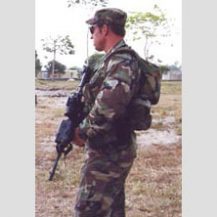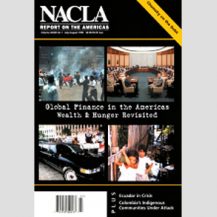The Ambiguous Nature of “Collaboration” in Colombia
Most Colombians have done something that might result in them being labeled a collaborator or sympathizer by one of Colombia’s armed groups.
This text originally published: 29 March 2004

One of the better known and most tragic facts about the Colombian civil war is that the majority of its victims are civilians. In the standard Associated Press tag-line that ends almost every piece the wire service files on Colombia, “At least 3,500 people, mostly civilians, die in the fighting every year.” Perhaps unintentionally, this phrase casts the civilian deaths in a manner that implies they occur in combat, in the crossfire of the conflict between armed groups. But what is lesser known about this aspect of Colombia’s war is the way in which so many of these civilian deaths are cast by the various armed factions—both legal and illegal—as the justifiable elimination of “collaborators” and “sympathizers” of the enemy. Though such phrases are frequently cited in press reports as the reason for civilian deaths, the parameters of what qualifies as “collaboration” are left almost utterly unexplored by mainstream coverage.
Under international law, civilians are considered non-combatants unless they partake in activities that seek to physically harm combatants or their war materiel. It is important to understand that while many civilians may harbor sympathies for one side or another in the conflict, few civilians overtly assist or harass the armed groups in any substantive way. The majority of Colombia’s civilians are caught in a situation where they must be cautious at all turns not to display allegiance or aversion to the armed group(s) that hold(s) sway in the region where they live and work. Despite their best efforts to avoid involvement, thousands of civilians are murdered by the armed groups—and thousands more are intimidated to the point where they flee their homes and become internally displaced person or refugees—for simply going about their daily activities. This article attempts to explain some of the ways in which civilians are cast as collaborators, and in so doing, to shed light on the ongoing human tragedy in Colombia.
Simply put, just about every Colombian has done something that might result in him or herself being labeled a collaborator or sympathizer by one of Colombia’s armed groups. In truth, the armed groups act with impunity and do not necessarily have any rationale behind who they target; the right-wing paramilitaries of the United Self-Defense Forces of Colombia (AUC) have proven themselves particularly adept at show killings and massacres that victimize unwitting civilians and leave an indelible mark on the popular consciousness.
That said, on a general level there are overarching attributes that can tarnish whole sectors of the population as alleged collaborators or sympathizers in the eyes of one armed group or another. For instance, to the guerrillas of the Revolutionary Armed Forces of Colombia (FARC) and the smaller National Liberation Army (ELN), by and large any wealthy Colombian is seen as fair game for the kidnapping-for-ransom schemes that partly fund their insurgencies. Of course, as the guerrillas cast their nets in what they call “miracle fishing,” they occasionally catch people who don’t fit the traditional prerequisites for ransom, as was the case in the FARC’s February raid on a well-to-do apartment complex in Neiva, where the guerrillas abducted four people, one of whom was a servant they mistook for someone more affluent.
The AUC is every bit as prone—if not more so—as the FARC and ELN to look upon wide segments of the civilian population as willing conspirators for the enemy. For the AUC, all labor organizers and human rights workers are akin to guerrilla collaborators, and thus are “justifiable” military targets. The AUC are not alone in this regard: many members of the Colombian military and police forces openly express disdain for human rights and labor activists, accusing them of working for the guerrillas. Even Colombian President Alvaro Uribe has railed against human rights workers—echoing former Paraguayan dictator Alfredo Stroessner’s remark that human rights were the Trojan Horse of international communism—by taunting rights activists to “take off their masks and stop hiding their ideas behind human rights.” With wide brush strokes like these, many Colombians can swiftly be painted as collaborators. It’s no surprise then, that Colombia leads the planet in terms of kidnappings-for-ransom and murders of labor organizers.
Beyond these broad parameters, there are many more levels of perceived “collaboration” in Colombia. While the following discussion is by no means exhaustive, it does illustrate the extent to which an armed group can cast almost any civilian action as collaboration with the enemy. Human Rights Watch and other human rights groups have repeatedly documented such cases. Sadly, the following scenarios are the everyday reality in which most Colombians live.
One recurrent theme in accusations of collaboration is “guilt by association,” though in Colombia’s boundless war, most victims are never afforded a chance to prove their guilt or innocence. In this climate, if one person is accused of collaboration with an armed faction, his or her entire family is often considered suspect. This principle has frequently been applied to the entire populations of towns, especially by the state security forces in reference to towns and villages in guerrilla-dominated areas.
In a parallel manner, attendance at rallies, church-sponsored meetings, and other events that articulate a certain political line is enough to get someone branded a collaborator; state authorities frequently photograph attendees at such events to compile lists of suspects, despite the fact that freedom of assembly is protected by Colombia’s Constitution. It is a perverse extension of this guilt by association principle that, just as union membership or class affiliation can “justify” targeting civilians in the eyes of Colombia’s armed actors, so too can mere attendance at civic events or openness to a political trajectory be construed as active collaboration with the armed groups that share some of those political views. In such a climate, Colombian civilians cannot realistically hope to engage in political discourse that might lead to a peaceful resolution of the conflict.
A second class of activities that frequently lead to charges of collaboration can be characterized as the “catch-22 of conflicting demands,” whereby civilians are caught between two or more armed groups and forced to make “choices” that will invariably aggravate one of the armed actors. There are countless incidents of shopkeepers in rural small towns who have sold produce or supplies to one armed group, only to be accused of collaboration with that group when a rival armed faction comes to town. In a variation on the tactic, merchants are frequently threatened by one armed faction and ordered not to sell to members of another armed group; disobeying the order will draw the ire of the group that issued the threat, while obeying it leads the boycotted group to assume the merchant is sympathetic to the other side—in this non-choice, either path the merchant opts for is tantamount to a death sentence.
The same principle is readily applied to other forms of succor, such as providing shelter or assistance to persons alleged to be members or partisans of an armed group. It’s a measure of the absurdity and the extremity of Colombia’s war that a butcher who sells a few kilos of meat to some guerrillas becomes a collaborator in the eyes of the paramilitaries, or vice versa, and that this “collaboration” is punishable by death.
A third form of alleged civilian collaboration with armed groups is “the act of informing,” or being perceived to inform, an armed group. The armed groups refer to alleged informers as sapos (toads). But what counts as “informing” in Colombia’s war zones differs greatly from the espionage-type activities that first come to mind for those accustomed to societies not torn by internal conflict.
What passes for “informing” in Colombia more closely resembles civilians under informal interrogation saying what they think a given armed group wants to hear. Though it cannot be denied that some civilians actively supply information to the armed groups with which they identify, the fact is that informing is more often than not an act that ordinary Colombians feel compelled to do, often in situations involving direct contact with armed combatants. In a broad sense, informing can also include acting as a messenger for an armed group, though this, too, is often done under duress.
Colombians face many chances of being interrogated by the armed groups. Police patrol the towns, conducting sweeps of bars or rounding up people en masse for questioning. All the armed groups—legal and illegal—set up checkpoints on roads and rivers at which they inspect documents and ask questions about civilians’ intended destinations and activities. These encounters with heavily armed combatants are nerve-wracking for civilians, as many kidnappings and summary executions begin with a stop at a checkpoint. Civilians have to parse their words carefully whenever in contact with any of the armed groups so as to avoid a potential verbal slip-up that might make them appear prejudiced toward one side or another. Moreover, civilians have to be guarded about who might be listening surreptitiously when they speak in public.
The fear of resembling—or even inadvertently becoming—an informer, or simply of being overheard saying something that sounds too partisan, cannot be underemphasized in Colombia. Armed groups repeatedly cite informing as a “justification” to level accusations of collaboration, although simply supplying information does not convert a civilian into a combatant. It is precisely this fear of “informing” an armed group either directly or indirectly about anything relevant—or fear of one’s words getting back to an armed group—that has stifled the ability of Colombian civilians to speak freely. Instead, a self-protectionist self-censorship characterizes the public speech of many civilians in Colombia’s conflict zones, reinforcing the near-monopoly on political discourse wielded by the armed groups.
Without negating actual instances of civilian partnership with specific armed groups, it is crucial to understand that little or nothing the vast majority of Colombian civilians do in their daily lives has any significant military or strategic benefit to any of the armed groups. But the line between combatants and non-combatants, and between collaboration and everyday activity, has become utterly blurred in Colombia’s war.
Notes
Image: A massacre victim shoved in a hole in Colombia. Photo by Garry Leech
This article was extracted from the Colombia Journal Special Report, "Civilian ‘Collaborators’ in Colombia’s Conflict", which expands on the themes here, including a discussion of the ever-shifting front lines of the war in Colombia.


